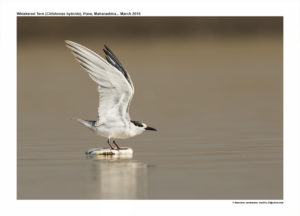Whiskered Tern

Whiskered Tern Chlidonias hybrida
Etymology:
- Childonias : Greek word khelidoniosswallow-like derived from khelidon –swallow
- Hybrida: Latin word for hybrid
Vernacular names: Hindi: For all terns – Tehari, Ganga cheel, Machhlauka, Koorari, Sans: Bharat sitkarnakurri, Kash: Krind, Keru, Pun: Taheri, Gond: Kivi,Guj: Kashmiri vabagali, Mar: Tamramukhsurya, KalledarSuray, Ta: For terns – Aala, Te: Samudrapu kaki, Ramadasu, Reeva pitta, Mal: Kadalkakka, Kan: Choukabaalada tern, Sinh: Muhudulihinia
Distribution in India: Breeds in Kashmir and widespread winter visitor in India.
Description: Size of 23–29 cm; wt. of 60–101 g; wingspan of 64–70 cm. It is a slender, medium-small tern, with wings more rounded; shortish tail with only slight fork; forehead to nape is black, with contrasting white cheeks; upperparts, including rump and tail are mid-grey. The underparts are grey, darker on belly, with contrasting pale grey underwing and white undertail-coverts; iris is dark brown; bill is dark reddish, legs are red. The non-breeding adult is very pale above and below, with dark-flecked pale crown, black patch behind eye merging into dark band across nape, and black bill.The female is significantly smaller than male in all dimensions. The juvenile has head pattern similar to non-breeding adult, but face washed buff and hindneck is tipped dark grey; mantle, scapulars and tertials darker, with buff tips.
Habitat: It is found in vegetated inland lakes, marshes and rivers, mainly in lowlands.
Food habits: It eats terrestrial and aquatic insects, like water beetles, Odonata and their larvae, grasshoppers, flying ants, spiders; also tadpoles and frogs, small crabs, small fish. .The males take larger prey and a higher proportion of vertebrate prey than females, which are smaller. It feeds over lakes, marshes, and rice fields, but also over sprouted farm fields, and coastal lagoons, tidal mudflats and estuaries. It flies back and forth or flutters above water, then swoops (aerial-dipping) or drops (hover-dipping) to pick up small surface items; infrequently engages in plunge-diving. It hawks insects over fields and lake margins; sometimes feeds behind plough.
Breeding habits: They breed in May–Jun in Europe, Nov–Dec in Australia and Dec in Tanzania. They form synchronous sub-colonies. The nest is broad but flimsy and made of stems or decaying rushes, placed on floating or emergent vegetation over water, in very shallow water. The nest may rest on bottom; alternatively nest of dry grass on water-lily leaves. They may usurp grebe nest. They lay a clutch of 2–3 eggs. The incubation period is 18–20 days. The chicks on hatching can leave nest within one day and swim to vegetation. The fledging period is 23 days. The chicks are fed for few weeks even after fledging.